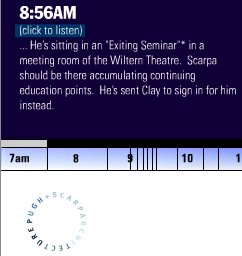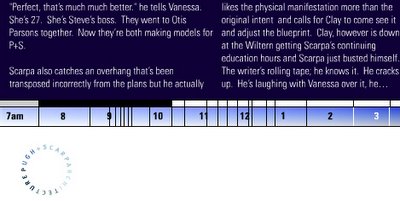Slippery Lecturer
Lawrence Scarpa, of Pugh + Scarpa Architecture (a typical, flash-heavy architect's site) in Santa Monica, CA, gave a lecture at NC State last night. His warm-up was to tell a Paul Rudolph anecdote from Scarpa’s days as a recent graduate working in Rudolph’s office in New York.
A Texan comes into Rudolph’s office.
Texan: I want a colonial mansion.
Rudolph: Okay.
Rudolph designs a “vintage Rudolph” building and presents it to the Texan.
Texan: Looks great. Let’s do it, but is it colonial?
Rudolph: Absolutely.
And so Scarpa reveals the origin of his squishy ethics. In his world, the client needs to be convinced in spite of their ignorance, so sometimes the client is told that everything is under control and moving smoothly when actually the project isn’t designed. And who, according to his own website, sends employees to “sign in for him” at continuing-education seminars (at which required continuing-education credit is earned) instead of attending them himself.* Why the charade? Why risk the humiliation and lack of trust if you are found out? And what was that Texan’s reaction when one of his more informed neighbors explained to him that he does not, in fact, have a colonial mansion?
By discussing and showing the work of sculptors and artists between slides of his projects, Scarpa is advocating building as an ongoing art project. He cited an “evolving” project, a funky platform structure for a film director that was built by a design team including the contractor as a member. It was built in only 12 weeks, from conceptual design to completion and was all fly-by-the-seat-of-your-pants; drawings were done by hand with construction quickly following. “What we ended up with was better, I think, than if we had worked on it for years and told someone to build it exactly as drawn.” That is debatable. What they ended up with looks hastily assembled; a collage of metal panels, pipes, and concrete supports.
The scale of the projects he’s working on seems to affect his attitude towards the contractor. If it’s small, he and the contractor are equals with a common goal. If it’s large, “We treat the contractor like an assembler not like a builder.” Which is it? Is the contractor competent or not? How does the contractor feel about being treated as an assembler? “They were thrilled to work on something different than they normally do.” I’m sure they were.
As a founding member of LivablePlaces.org, Scarpa says, “We’re not active enough politically as architects.” The non-profit held a design competition for Santa Monica affordable housing without specifying a program. Naturally, the architecture-firm participants asked questions about the program, how many bedrooms per unit, etc. Scarpa saw this as a failing. “We’re so far removed from shaping our cities. We’ve become like the window dressers.”
When I asked how much contact he has had with the future residents of this affordable housing he said, “None.” He stressed that those involved in the project were creative people and knew the needs of the community.
“Wasn’t that the problem with the horrible housing projects of the ‘60s, that the architects came in and said ‘You should live this way’?” I asked. He responded in the negative. He said that those projects were federally-dictated where this one is local. I don’t see the difference between dictation originating locally or nationally, it’s still dictation. Perhaps, what he means is that this affordable housing isn’t for the poor. Olivecourt, the result of the design competition, has starting prices in the "low $300,000’s" which makes it like a speculative condominium project in most other urban centers.
If it were for the poor, the real poor, not involving the future residents of this project would appear to be only the latest paternalistic effort to elevate the poor through “good design.” It would be another way to get Channel 4 News to do a cheesy feature story on your organization, because, as Scarpa says in relation to sustainable design, “You don’t have to do much to look like a hero.”
*Click "Features". Click "A Day In The Life". Click just to the right of the number 9, for image one below. Then click the number 10 for image 2.





0 Comments:
Post a Comment
<< Home